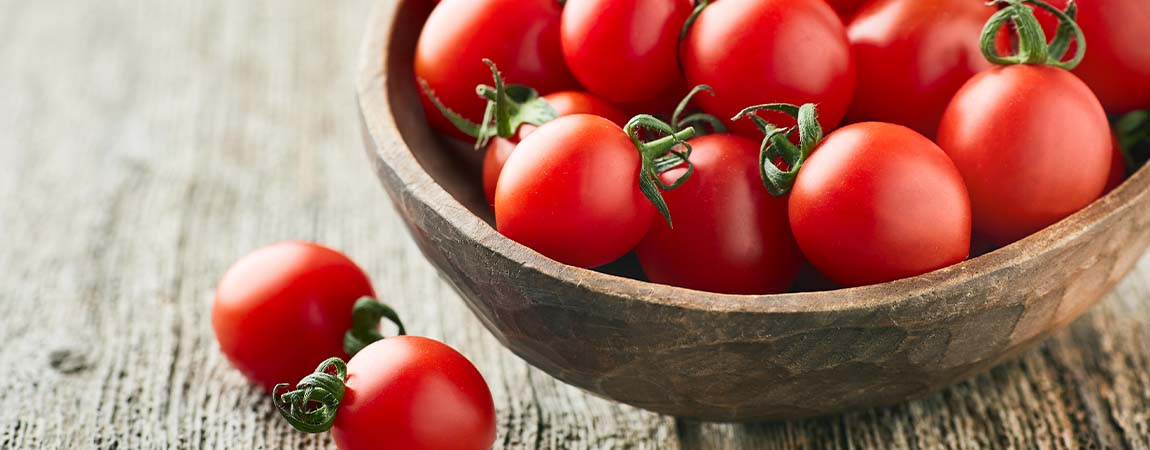
Pachino is a small Sicilian municipality located in the south east of the island. To understand why the tomato produced there is famous throughout the world, it is interesting to note that Pachino is the place in Europe with the highest number of hours of light.
Furthermore, the brackish water coming from aquifers close to the sea is absorbed by plants and transformed into salt. This particular combination of light and water gives the tomato grown in this area its unmistakable full and sweet taste.
What are Pachino Tomatoes?
The Pachino tomato obtained the PGI label (Protected Geographical Indication) in 2013. It is widely believed that the Pachino tomato has always been cultivated in these parts of Sicily.
It's not exactly like that: in the sense that tomatoes have been grown in these areas, one can say, forever, but not in the quality we all know.
In 1989 the Israeli seed company Hazera Genetics launched two new tomato varieties in Sicily: the Naomi cherry tomato and Rita vine tomato.
Initially local producers were skeptical, but the Pachino cherry tomato soon became famous and appreciated.
Their seeds are hybrids, the result of scientific research conducted in recent decades. Every year farmers have to buy young plants directly from nurseries: the seeds of previous tomatoes are not used because they would risk losing the characteristics that make them so desirable.
In the 80s Italians ate practically nothing other than the traditional “salad tomatoes“, which varied in size and shape and were green and red in color.
Cherry tomatoes were not as popular in supermarkets as they are now. Tomatoes of that type, reddish yellow in colour, were grown in the vegetable gardens of Southern Italy and were stored in bunches in a sheltered place to be consumed in the winter months.
However, from the PGI request form we learn that the production of tomatoes began in Pachino in 1925 when they were planted to replace the vines that grew along the coastal strip. Vegetables grown in this area ripen 15-20 days earlier than elsewhere.
Where the Pachino Tomato is produced
In addition to Pachino, the denomination PGI also includes Ispica, Portopalo and Noto.
The tomatoes that grow in this area are the result of the southern sun, bright winter days, clay soil and mild climate. The ideal habitat of the plant is around 23 degrees centigrade and should never be exposed to temperatures lower than 10/12 degrees.
How Pachino Tomatoes are produced
The Pachino tomato plant prefers the milder and warmer climates of the southern regions, even when it is found hundreds of meters above sea level. It is quite resistant, but suffers when the temperature drops too much.
Pachino requires frequent and constant irrigation. Irrigation is carried out using aquifers from wells located in the production area. It is important not to wet leaves and fruits because this could lead to fungal diseases.
The Pachino tomatoes come harvested by hand from July to October, when they are bright red in color and fully ripe. They can be stored in the refrigerator for about fifteen days.
Tomato cultivation takes place in a protected environment, in covered greenhouses. During the summer period, anti-insect nets are also used.
Types of Pachino tomatoes
The regulations relating to Pachino Tomato PGI classify and protect four different types of tomato, with different peculiarities and intended for different markets.
– Round smooth: it is small and round, of dark green color, unique for its very strong flavor. It is highly appreciated by consumers across the Alps. Its fruits have an unparalleled consistency.
– Bunch: it can be green or red. It is round, smooth, with a bright color and a very dark green collar. Its weight varies according to the saltiness of the soil.
– Costoluto: it is a large fruit, very pleasant from an aesthetic point of view, with marked ribs, and a very dark and bright green colour. This type has achieved the preference of the internal market, replacing during the winter (the optimal period for the production of this type) the round one ideal for salad. The ribbed tomato highlights its best characteristics if grown in soils with very high salinity.
– Cherry: it is characterized by the appearance of a 'cherry' on a bunch herringbone shape with round and small fruits.
How to recognize the Pachino tomato
The Pachino Tomato PGI brand represents the image of the island of Sicily with a circle at its outermost point, where the production area is located. Its shape is a rhombus with dark green rounded corners, a pale yellow round internal profile, with light green outlines.
The geometric figure is softened by the white writing "Pachino tomato” enclosed in a rectangular black stripe. At the bottom of the brand there is the writing PGI in pale yellow.
The use of this trademark is controlled by the Consortium. The Pachino Tomato PGI must be packaged using new, disposable packages of different types, recognized by current regulations, which do not exceed 10 kg in net weight.
A guarantee seal must be affixed to each package. Open packaging is permitted only if the individual fruits are identified by adhesive labels with the characteristic PGI mark.
As regards the type of vine tomatoes, clips with the characteristic PGI mark are used instead of adhesive labels. In any case the packaging must be labelled.
The contents of each package must be homogeneous and include tomatoes of the same variety or type of fruit, quality and size. Furthermore, the fruits must be homogeneous in terms of maturity and colour.









